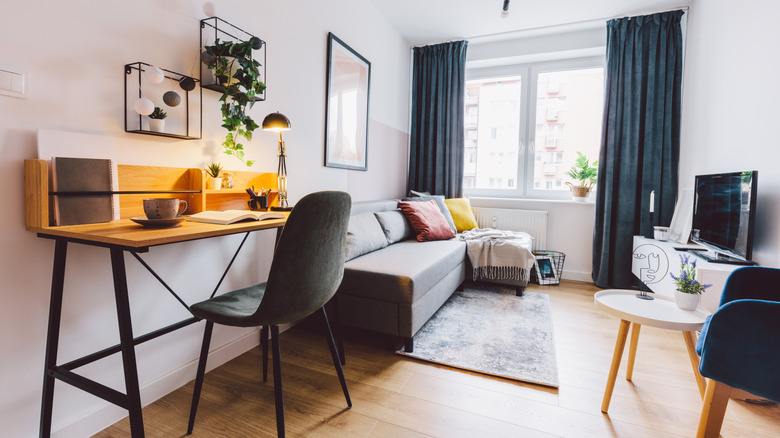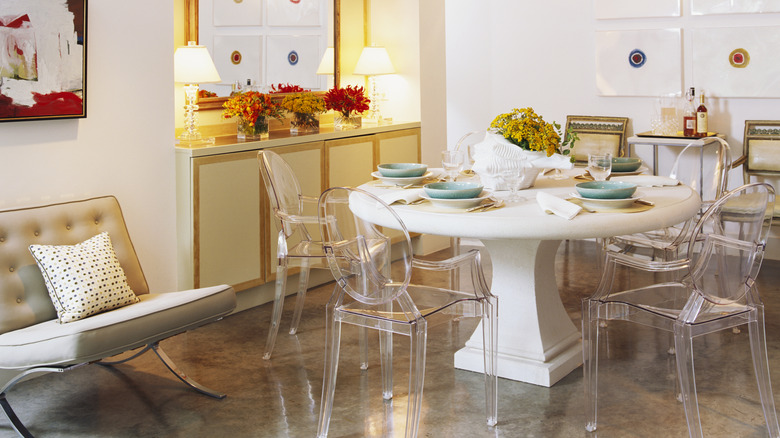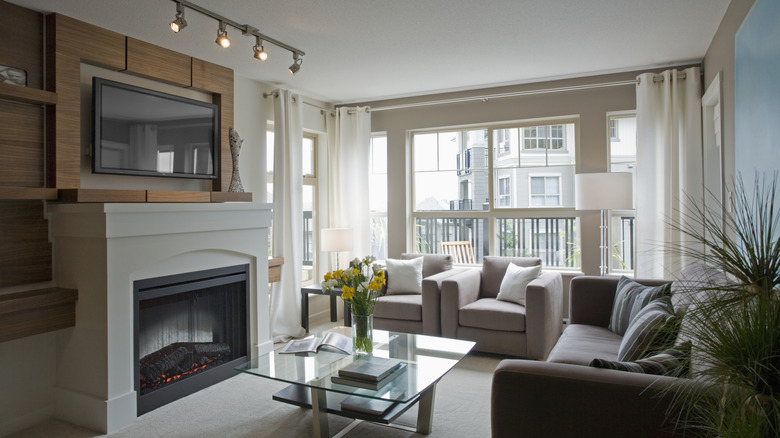The Design Hack To Visually Declutter Crowded Rooms Without Sacrificing Furniture
Living in cluttered spaces can cause emotional and mental drain, diminishing life satisfaction. But since we need our seating, tables, storage, and surfaces, sacrificing precious furniture to open up our compact spaces feels impractical. Fortunately, there's a declutter hack for décor that you can deploy to get out of this pickle. Enter clear furniture. Alternatively called transparent furniture, clear furniture includes any furnishing made of acrylic or Lucite (the brand), but also ones molded from resins and tempered glass.
Since acrylic furniture pieces offer immense optical clarity, meaning they allow the light to pass through them (sometimes up to 92%), they don't inhabit much visual space. In short, they look see-through. Because of this, they give off an illusion of an open, breathable environment without sacrificing functionality. But how does this décor hack work, and how can you feature it inside your home? To know the finer details, we got in touch with Erika Dale, interior designer and founder of Erika Dale Interior Design, for an exclusive interview. Here's what she had to say.
Utilize clear furniture sparingly in your room
In her exclusive interview with House Digest, Dale reveals, "Clear furniture has a wonderful way of nearly disappearing, leaving just a small sheen of glossy acrylic or Lucite to elevate a space without adding visual weight." This is something that you'll be hard-pressed to achieve with your gorgeous wood furniture with its frozen lines and burnished stains. "Because you can see right through it [clear furniture], the subtle pop of interest allows the eye to keep moving through the space rather than stopping on a solid piece of furniture, causing the space to look bigger," adds Dale. In other words, your room appears lighter and less crowded, yet is functional with a modern aesthetic.
But does that imply you may trade out most, if not all, of your existing furniture for clear pieces? Dale cautions against taking such a measure, encouraging you use it sparingly instead. "When used in small pops, the effect of clear furniture can be elegant and interesting, adding another layer of dimension and nuance to a space. However, when used too much (one or two pieces are plenty), it loses its effectiveness," she clarifies. After all, an excess of anything is bad, and clear furniture is no exception.
Incorporating clear furniture for a decluttered home
So, acknowledging that this design hack works, what furniture can potentially be replaced? "I love a great acrylic coffee table, single desk chair, pair of end tables around a sofa, bar cart, or console table," Dale says in her exclusive House Digest interview. HGTV followers may have already seen its semblance when Hilary Farr used acrylic chairs in a small dining room as a space-saving seating design trick. If not, perhaps take this as your cue to scour Pinterest boards and Instagram reels for the versatile coffee table trend that goes well with any style, involving a waterfall coffee table — usually acrylic or glass. When onboard, look for pieces made of cell cast acrylic sheets, as they offer a clear surface, are lightweight, and showcase good UV resistance.
However, bear in mind that this design hack has one major downside. Clear furniture "shows fingerprints and scratches very easily, so it is not the best suited for high-traffic areas," warns Dale. So, unless you're planning to tell your kids off regularly and give lifelong trauma, or mask the scratches on your Lucite furniture with curios and books, steer clear of it. Instead, Dale's suggestion is to "opt for normal or larger size pieces to give the space more impact with fewer actual pieces." That way you're unlikely to cram your space with multiple small or undersized pieces that crowd the space with visual clutter.


